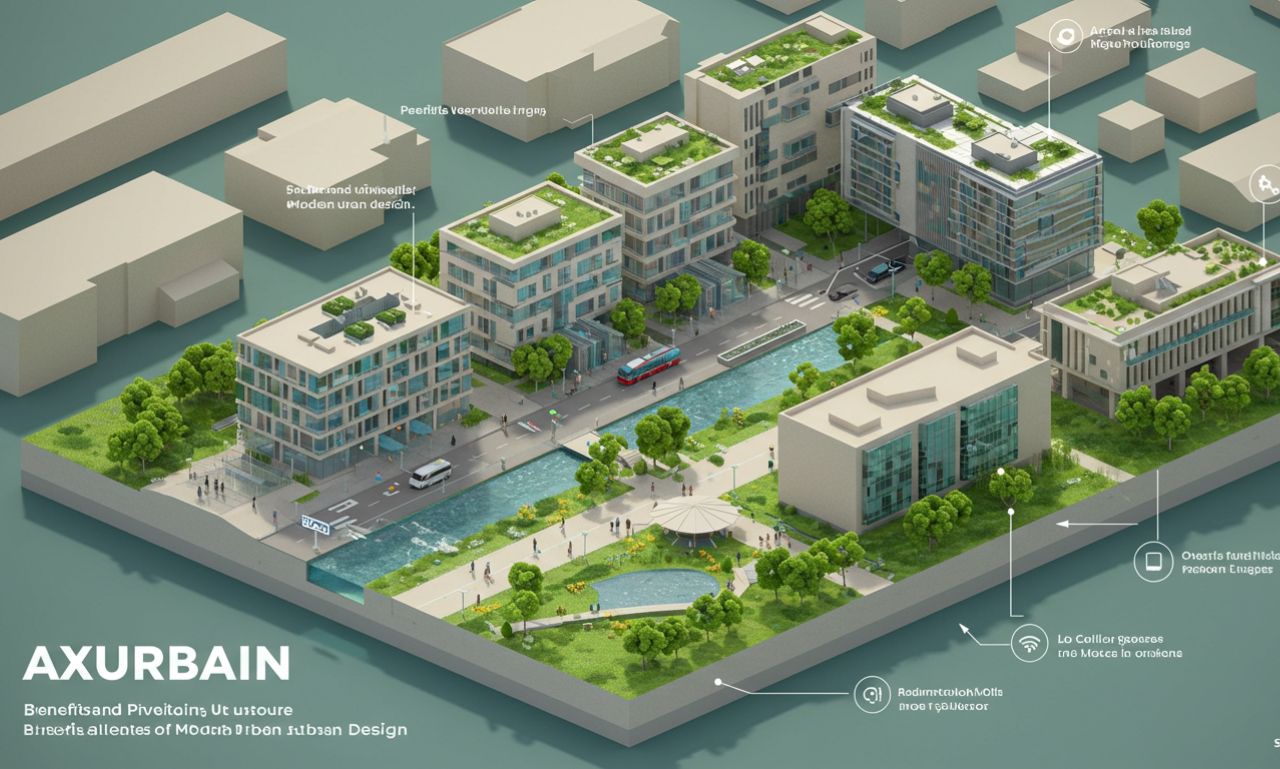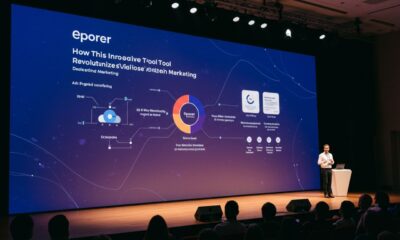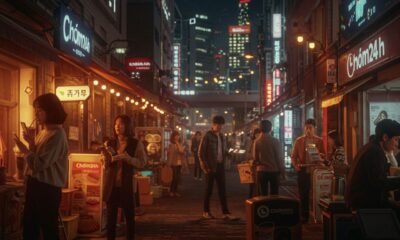General
Axurbain: Benefits and Challenges of Modern Urban Design

Urban design is evolving, and the concept of Axurbain stands at the forefront of this transformation. Picture a world where cities are not just concrete jungles but vibrant ecosystems that blend modern innovation with community spirit. This emerging trend focuses on crafting urban spaces that prioritize sustainability, inclusivity, and economic vitality.
As we navigate through bustling city streets or serene parks, it’s essential to understand how Axurbain shapes our environments. It’s about more than aesthetics; it encompasses the very fabric of our daily lives. From green rooftops to multi-functional public spaces, Axurbain reimagines what urban living can be.
This blog will explore the benefits and challenges associated with modern urban design while showcasing successful projects that embody these ideals. Let’s dive into this exciting journey and discover what makes Axurbain a pivotal element in shaping future cities!
What is Axurbain?
Axurbain is a concept that reimagines urban living. It melds the essence of urban and suburban environments, seeking to create vibrant communities that are both functional and aesthetically pleasing.
At its core, Axurbain aims to enhance the quality of life for residents. This includes increasing accessibility to amenities while preserving green spaces. The idea is not just about buildings but integrating nature into everyday city life.
With Axurbain, innovative design meets social needs. Infrastructure evolves alongside community requirements, fostering inclusivity and interaction among diverse groups.
This approach also emphasizes sustainability by prioritizing energy-efficient solutions and promoting public transport systems over car dependency.
In essence, Axurbain represents a shift toward holistic urban planning where connectivity and environmental harmony coexist seamlessly with modern conveniences.
Benefits of Modern Urban Design
Modern urban design brings a multitude of benefits that enhance city life. By prioritizing walkability and public spaces, it encourages community interaction. People can connect, share ideas, and create vibrant neighborhoods.
Sustainable practices are at the core of modern design. Green spaces improve air quality while providing habitats for wildlife. This focus helps cities combat climate change through better resource management.
Economic growth also thrives in well-designed urban areas. Attractive environments draw businesses and tourists alike, leading to job creation. A thriving local economy fosters innovation and entrepreneurship.
Furthermore, modern design promotes inclusivity by accommodating diverse populations. Accessible infrastructure ensures that everyone can enjoy the city’s amenities regardless of their background or physical ability.
Health is another crucial aspect benefiting from thoughtful urban planning. Improved access to parks and recreational facilities encourages physical activity among residents—leading to healthier lifestyles overall.
Economic Growth and Job Creation
Modern urban design, particularly through the lens of axurbain, plays a pivotal role in driving economic growth. By transforming cities into dynamic hubs, it attracts businesses and investments. This influx not only boosts local economies but also enhances overall infrastructure.
Job creation is another significant aspect of this transformation. New developments often lead to the establishment of various industries that require skilled workers. Construction projects alone generate thousands of jobs, while revitalized neighborhoods foster entrepreneurship.
Moreover, modern urban environments encourage innovation by providing spaces for startups and tech companies to thrive. Co-working spaces and incubators are essential features in these designs that nurture creativity and collaboration among residents.
As communities evolve under axurbain principles, they become more appealing to diverse populations seeking opportunities. This shift can reduce unemployment rates while promoting a sustainable labor market aimed at long-term prosperity.
Challenges of Modern Urban Design:
Modern urban design faces significant challenges that require careful consideration. One major issue is balancing innovation with tradition. Cities often have rich histories, and integrating new ideas without erasing the past can be tricky.
Socio-economic inequalities also pose a considerable challenge. Urban areas frequently struggle to provide equal opportunities for all residents. Ensuring access to quality housing, education, and services for marginalized communities is essential yet complex.
Environmental sustainability cannot be overlooked either. As cities grow, their ecological footprints expand too. Designers must find ways to promote green spaces and reduce pollution while accommodating increasing populations.
These challenges are interconnected and require thoughtful strategies that engage various stakeholders in the community. Addressing them effectively will shape the future of urban living for generations to come.
Balancing Innovation with Tradition
Balancing innovation with tradition is a crucial aspect of axurbain. Cities are evolving, yet the roots of their culture must remain intact. New designs can bring modern amenities and efficiency, but they shouldn’t overshadow historical significance.
Integrating cutting-edge technology in urban spaces often clashes with traditional architecture. Striking this balance allows cities to evolve while celebrating their past. This synergy cultivates a unique character that attracts residents and tourists alike.
Local communities should play an active role in these discussions. Their input ensures that innovations respect cultural heritage rather than erase it. Engaging stakeholders fosters pride and ownership in urban development projects.
Preserving landmarks alongside introducing new infrastructures enhances city aesthetics and functionality. It encourages creativity without losing identity, creating vibrant environments where history meets progress seamlessly.
Addressing Socio-Economic Inequalities
Addressing socio-economic inequalities is a crucial aspect of modern urban design. Axurbain aims to create inclusive spaces that cater to diverse communities. This means ensuring that everyone, regardless of background or income, has access to essential resources.
Urban planners must prioritize affordable housing and public services. By doing so, they can level the playing field for all residents. Well-designed public transportation systems also play a vital role in connecting underserved areas with job opportunities.
Engaging local communities in the planning process fosters understanding and trust. Their input helps shape strategies that address specific needs and concerns.
Furthermore, integrating green spaces enhances quality of life across socio-economic strata. Accessible parks promote health and well-being while encouraging social interaction among different groups.
Tackling these disparities requires thoughtful solutions tailored to each unique urban environment.
Ensuring Environmental Sustainability
Ensuring environmental sustainability is a cornerstone of the axurbain concept. Urban spaces must adapt to the changing climate while promoting a healthy ecosystem.
Integrating green infrastructure can significantly reduce urban heat islands. This involves using trees, parks, and green roofs to cool city areas naturally.
Water management also plays a crucial role. Implementing rain gardens and permeable pavements helps in managing stormwater effectively while reducing flooding risks.
Additionally, energy-efficient buildings contribute to lower carbon footprints. Utilizing renewable energy sources like solar panels not only meets energy demands but also supports local economies.
Community engagement fosters awareness about sustainability practices. Educating residents on eco-friendly choices encourages participation in preservation efforts and enhances collective responsibility towards the environment.
Sustainable practices create vibrant cities that thrive without compromising future generations’ needs.
Examples of Successful Axurbain Projects
Cities around the globe are embracing axurbain principles, showcasing innovative projects that redefine urban living.
One standout example is the High Line in New York City. This elevated park transformed an abandoned railway into a green space for residents and tourists alike. It fosters community interaction while promoting biodiversity in an urban environment.
In Paris, La Défense exemplifies modern architectural design with its unique skyline of skyscrapers. The blend of business and public spaces creates a vibrant area where work meets leisure seamlessly.
Closer to home, Melbourne’s laneways have evolved into cultural hotspots filled with street art, cafes, and boutiques. These revitalized areas breathe new life into older neighborhoods while supporting local businesses.
Each project demonstrates how thoughtful design can enhance urban experiences and foster connections among residents. They serve as blueprints for future developments aiming to create more inclusive and sustainable cities worldwide.
Future Outlook for Modern Urban Design
The future of modern urban design is poised for transformation. As cities evolve, they must adapt to emerging technologies and shifting societal needs.
Smart cities are on the rise, integrating technology into urban infrastructure. Innovations in data analytics and IoT can enhance public services, transportation networks, and energy efficiency.
Sustainable practices will play a crucial role in shaping these environments. Urban planners are focusing on green spaces, renewable energy sources, and eco-friendly materials to create healthier living conditions.
Community engagement is becoming increasingly important as well. Involving residents in the planning process fosters inclusivity and ensures that designs reflect diverse perspectives.
Moreover, resilience against climate change challenges will be essential. Future designs must prioritize adaptability to withstand natural disasters while promoting long-term sustainability for generations to come.
Through collaboration among stakeholders—governments, architects, and communities—the vision for axurbain can become a reality where innovation meets humanity’s needs.
The Importance of Collaboration in Achieving Effective Axurbain
Collaboration is the backbone of effective axurbain. It brings together diverse perspectives and expertise, fostering innovation in urban design. When architects, city planners, and community members work as a cohesive unit, they create spaces that are not only functional but also resonate with local culture.
Engaging stakeholders early in the planning process helps identify unique needs within communities. This grassroots input ensures designs reflect real-life experiences rather than theoretical ideals.
Moreover, collaboration encourages resource sharing among various sectors—public institutions can partner with private organizations to fund projects that benefit everyone.
As cities evolve, so too must their approach to development. By prioritizing teamwork across disciplines and demographics, axurbain initiatives can pave the way for sustainable growth while honoring tradition and inclusivity. The collective effort transforms visions into tangible realities that enhance daily life for all residents.
Conclusion
The concept of Axurbain is transforming the landscape of urban design. It pushes boundaries and redefines how we perceive our cities. With its focus on innovation, sustainability, and community engagement, Axurbain paves the way for economic growth while addressing pressing social issues.
However, implementing modern urban designs is not without challenges. Striking a balance between innovation and tradition requires careful planning. Cities must also face socio-economic inequalities that persist in many areas. Environmental considerations are paramount too; ensuring sustainable practices will be vital for future generations.
Successful examples around the globe showcase what can be achieved with thoughtful design and collaboration among stakeholders. These projects demonstrate that when communities come together with a shared vision, they can create vibrant spaces that benefit everyone.
As we look to the future, it’s clear that effective urban design hinges on cooperation among various sectors—government agencies, businesses, architects, planners, and residents alike.
Axurbain represents more than just a trend; it’s an evolution in how we think about living spaces within bustling metropolises. The journey ahead may have hurdles but offers immense potential for creating inclusive environments where people thrive.

-

 Health2 months ago
Health2 months agogel ooru: Incorporate into Your Daily Routine for Radiant Skin
-

 Digital Marketing2 months ago
Digital Marketing2 months agoEporer: How This Innovative Tool Revolutionizes Digital Marketing
-

 Technology2 months ago
Technology2 months agointernetchocks: The Impact of Online Communication and Connectivity
-

 Travel2 months ago
Travel2 months agoPertadad: Should Be on Your Travel Bucket List This Year
-

 Business2 months ago
Business2 months agoRowdy Oxford Lawsuit: It Means for Local Businesses and Community
-

 Lifestyle2 months ago
Lifestyle2 months agoNionenad: A Hidden Gem for Adventure Seekers and Nature Lovers
-

 Business2 months ago
Business2 months agoCharfen.co.uk: Empowers Entrepreneurs with Innovative Solutions
-

 Blog2 months ago
Blog2 months agoChóim24h: Your Ultimate Guide to 24-Hour Convenience